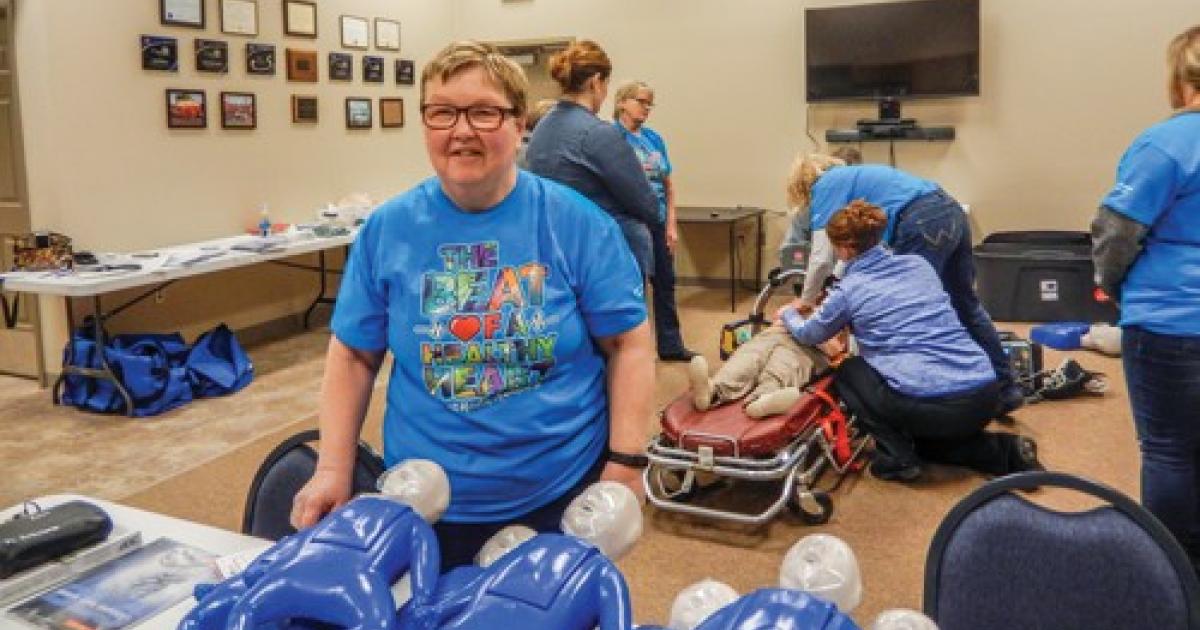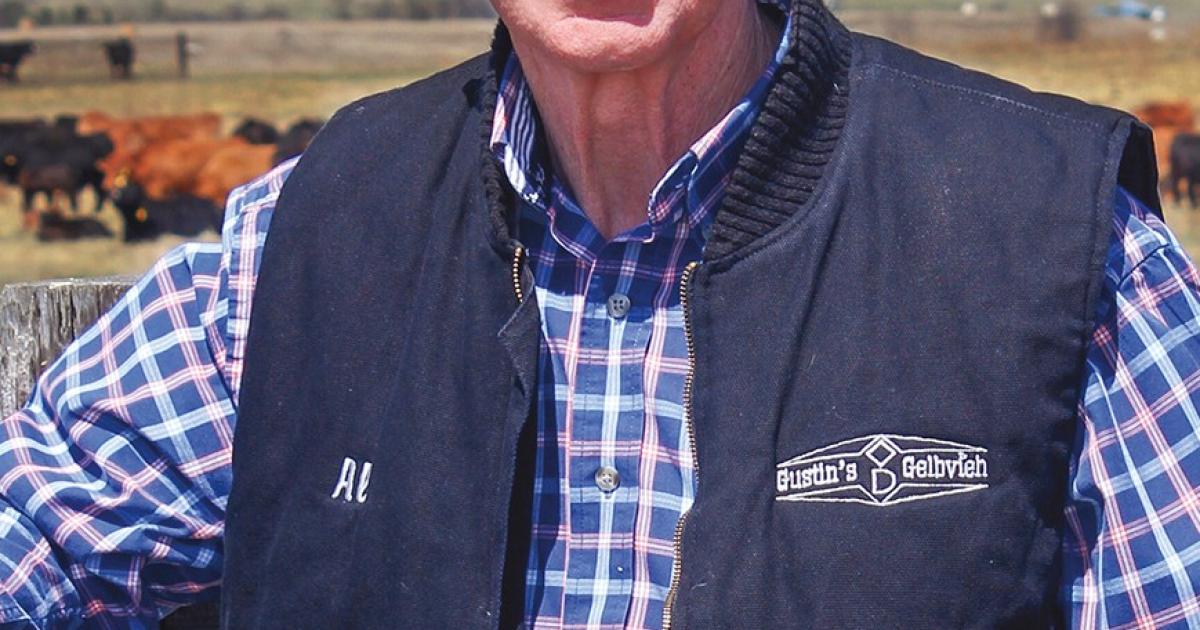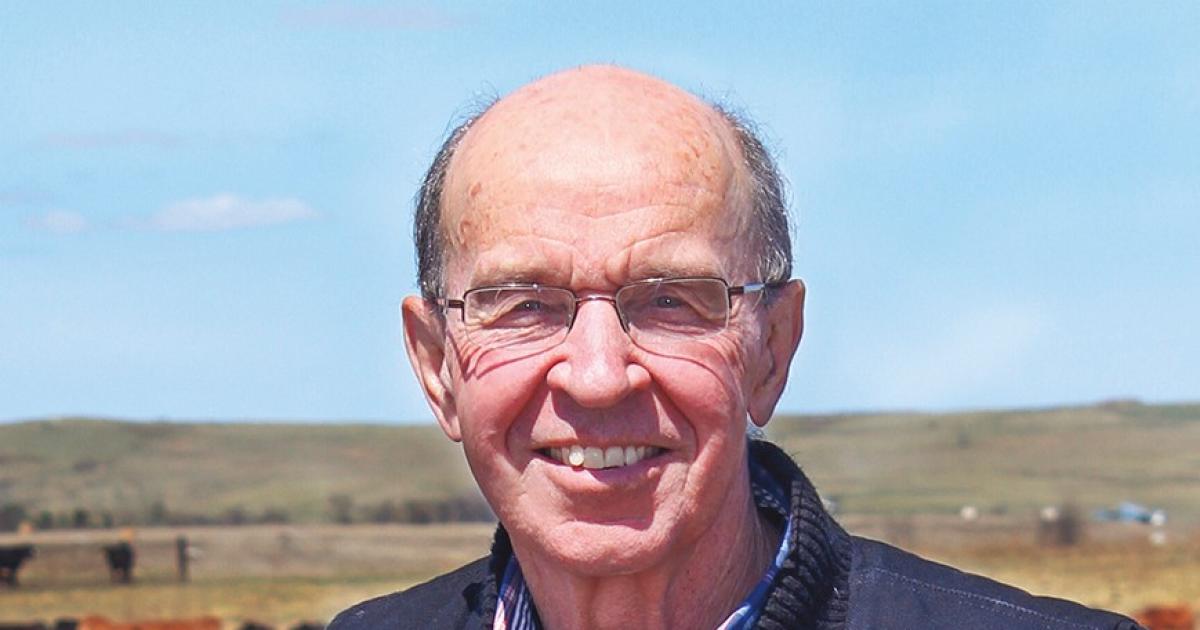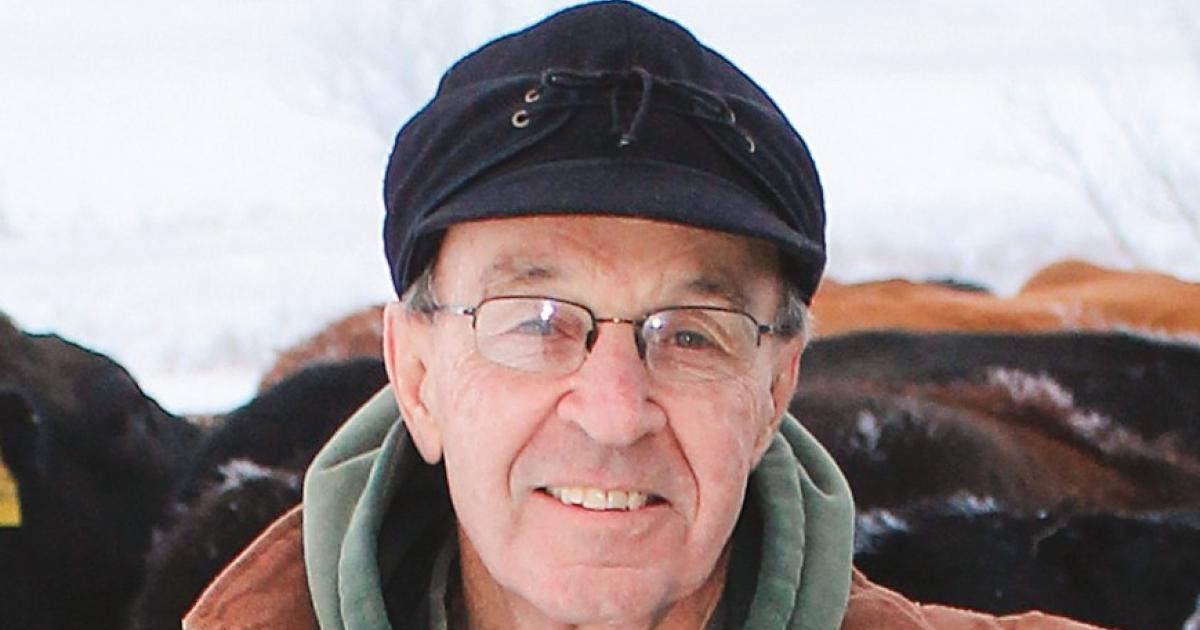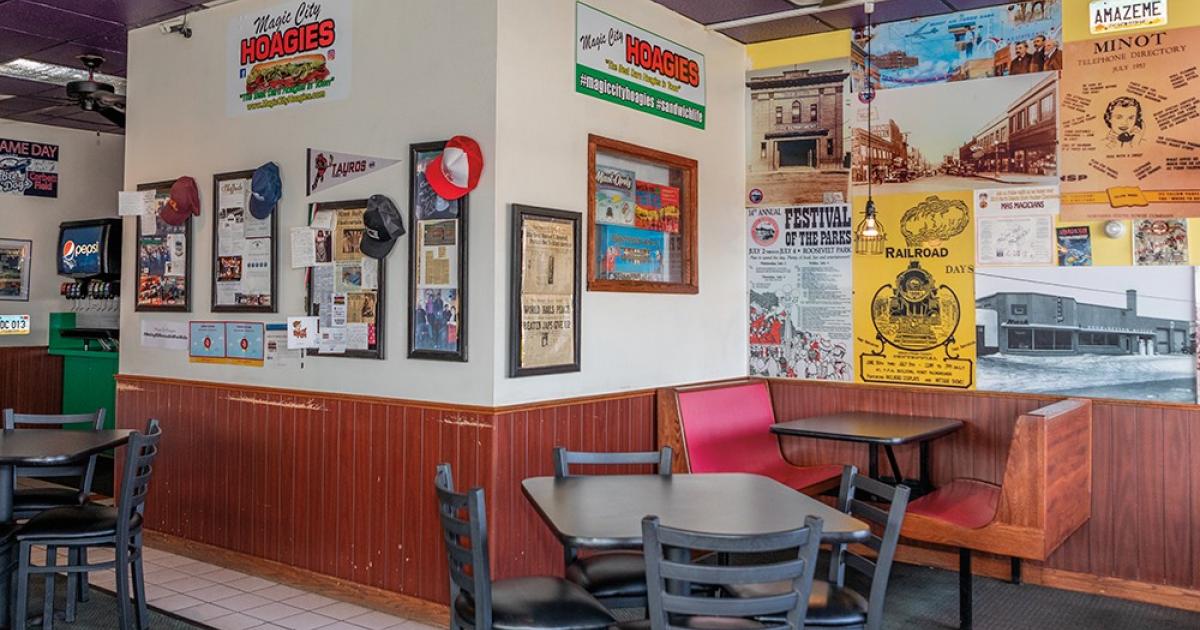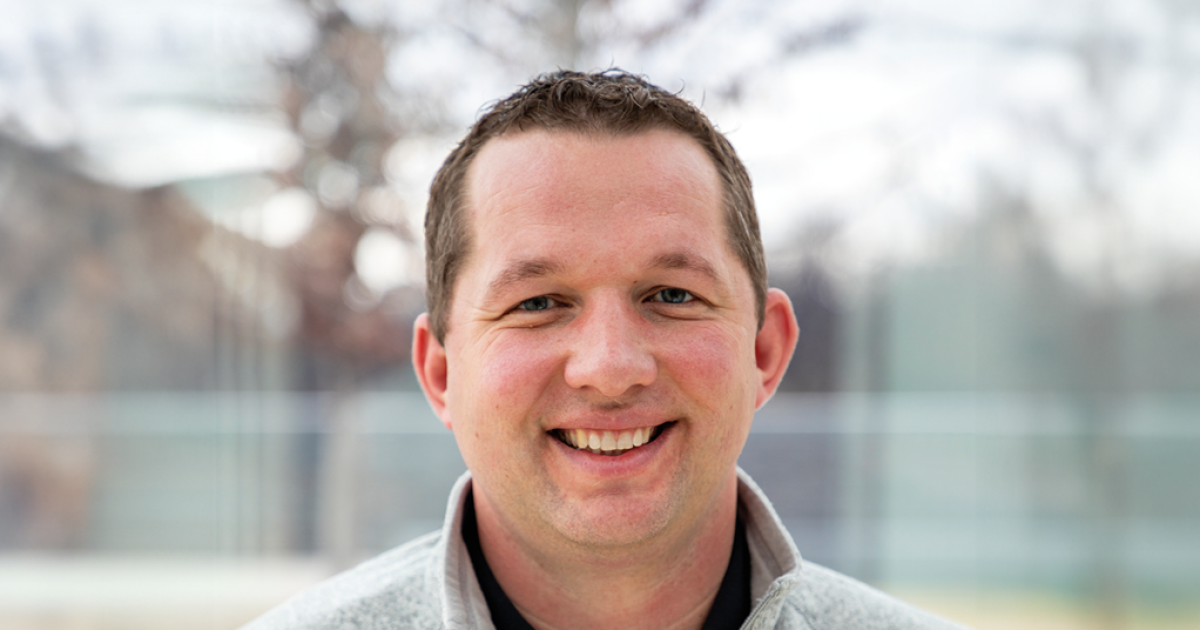Because there happened to be three off-duty emergency medical technicians at the Hebron ballpark one summer evening, Jerrid Soupir is alive today. Soupir was only 45 years old in 2016 when he collapsed and went into cardiac arrest while playing softball. He survived because EMTs who happened to be there knew what to do. Soupir’s experience provided the impetus for the Hebron community to be prepared when a community member has a cardiac event.
Kari Enget, left foreground, is a cardiac ready squad leader in Powers Lake, and is part of the CPR classes the community is conducting (Photos by Candi Helseth)
Hebron is among six North Dakota communities that have met Cardiac Ready Community standards.
The Cardiac Ready Community project is a partnership of the N.D. Department of Health (NDDOH) and the American Heart Association (AHA). The Cardiac Ready Community project promotes the AHA chain of survival, which can improve chances of survival and recovery for cardiac-related traumas and stroke. The goal is to train community members to respond immediately and appropriately to assist these individuals.
Powers Lake, a town of under 300 residents, was the first to achieve a Cardiac Ready Community designation. Rugby, New Rockford, Mayville-Portland and Valley City have also met the criteria. To date, an additional 26 North Dakota communities are working toward that goal.
“Survivability decreases 7 to 10 percent every minute someone is not given CPR/defibrillation and in areas where cardiac arrest doesn’t get immediate treatment, you are likely to see brain damage within 4 to 6 minutes,” says Shila Thorson, NDDOH state stroke and cardiac system coordinator. “We have many rural areas where the ambulance cannot get there that fast. Individuals can have a huge positive impact – if they know what to do. That’s why this project is important. Lives are on the line.”
Research demonstrates that survival and recovery rates improve for these victims when area residents:
• are aware of cardiac emergency signs and symptoms
• activate the 9-1-1 system
• begin CPR (cardiopulmonary resuscitation) immediately
• have public access to AEDs (automated external defibrillators)
In 2015, NDDOH and AHA were in early stages of implementing the Cardiac Ready Community project. At a regional EMS meeting, state leaders learned that the Powers Lake ambulance had unknowingly started the process. Squad member Jake Douts had applied for and received grant funding, which the EMTs were using to educate community members on cardiac symptoms and to teach free community CPR classes. Powers Lake’s ambulance squad has 20 members, all volunteers. The 10-township service area is federally designated as “frontier,” meaning it has a severely low population density and extreme health care barriers. If one of the state’s most rural communities could accomplish Cardiac Ready Community designation, others certainly could, too.
“We started with Powers Lake as our pilot program and now this is taking off like wildfire,” says June Herman, AHA senior director of advocacy. “Powers Lake is a great example of how EMS can pull together a cross-section of community leaders that all work together to improve community health care.”
PUBLIC EDUCATION
The first step in saving lives is teaching the public to recognize cardiac arrest symptoms and dial 9-1-1 right away. According to Thorson, mortality rates decrease when people seek medical assistance at the onset of symptoms and are transported to an emergency room by ambulance rather than private vehicle.
With training, ordinary citizens can perform lifesaving procedures. Five accredited instructors have taught CPR to almost all working members of the Powers Lake community, including most teachers and more than 80 students in grades 7-12. The committee has also sponsored several community education events that included various free health screenings. Thirty AEDs are in place throughout the service area. (AEDs are used in cases of cardiac arrest to restore the heart’s rhythm, while CPR maintains blood flow from the heart to the body’s organs.) Marie Wold, who lives 16 miles from Powers Lake, is among five rural squad members who keep an AED, emergency supplies and jump bags with oxygen at their homes to respond more quickly to calls. Wold is a member of Burke-Divide Electric Cooperative.
“We could not have done this without the committee of people from many different areas that have all donated their time and skills,” said Kari Enget, co-squad leader who co-chairs the cardiac ready team with Douts. Committee members represent factions that include the rural fire department, city council, local businesses, farmer/ranchers and individuals with medical skills.
While still in his hospital bed in Bismarck, Soupir ordered an AED for Hebron Brick where he works. He and fellow employees at Hebron Brick had talked about installing an AED for more than a year. They had even gotten price quotes. They just never got it done. Now, Hebron has 12 AEDs throughout the community. With an additional $8,000 in community donations, seven more are on their way.
PHYSICAL AND FINANCIAL SUPPORT
Using rural residents to improve response rates has been a primary focus for Rugby EMS. The service has full-time, paid staff and already had a comprehensive educational program in place when the state initiative began. Director Ken Reed says having full-time staff means the ambulance gets out the door faster, but some rural townships are still too far away. So far, Rugby has trained rural responders in 60 percent of its service area. The goal is to have at least one individual or family in each of its 30 townships to respond to neighborhood emergencies before the ambulance can arrive. Each residence receives a kit with an AED, CPR and bleed control supplies.
“If people have a broken ankle, they can wait for that ambulance, but if you have an acute trauma, you need a fix fast,” Reed commented. “Rural people are used to helping neighbors; that’s part of their lifestyle. When we offered to empower them with training and equipment, we found people willing to participate.”
Rugby EMS is fortunate to have financial support from Heart of America Medical Center and Enbridge, Reed said. But funding, and particularly AED costs, is an ongoing challenge for many rural communities. AHA has committed $100,000 through a matching grant program for AED purchases. House Bill 1210, passed by the North Dakota Legislature, established a grant program to reduce AED costs. Herman, who said state partners continue to seek ways to lessen financial burdens, added, “North Dakota has emerged as a national leader for building systems for those experiencing cardiac and stroke emergencies.”
“You don’t think it will happen to you until it does,” Soupir said. “I’m really glad those guys happened to be there.”
Thorson encourages all North Dakotans to become involved in the Cardiac Ready Community initiative. Go to https://cardiacready.doh.nd.gov(link is external) to learn more.
Candi Helseth is a freelance writer from Minot.


